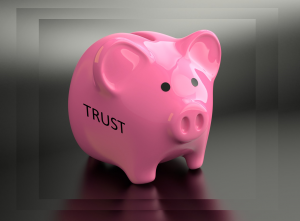
Trust … The Currency of Highly Effective Leaders

Why is love … in the context of valuing others as L2 … so impactful? Think about if for a minute. Think about the last time you felt someone else really treated you as valuable … or special. How did it make you feel about yourself? How did you feel toward that person? In the answer to this question, I believe, is a key to the effectiveness and impact of love. Beneath the appreciation, undergirding the new found sense of connection toward this person who graced you with ‘love’ … is what lies at the bedrock of all great, strong relationships. The result of love … of valuing others … is the creation of trust.
Trust is the currency of great leadership. In this sense, we can think of trust as a medium of exchange for relationships. Like other assets, trust has value and it’s typically acquired with a cost, whether it’s time, intention, sacrifice or effort. However, unlike other assets, real trust isn’t something that can be bought from others, rather (as EF Hutton used to say), “it’s earned”. It is our words and actions that help us earn, or lose trust with others.
To grasp the importance and pervasiveness of this idea of trust, let me personalize it for a minute. Let me ask, what happens when you have to work on a critical project with a colleague you don’t trust? Or what is your relationship like when you don’t trust a spouse, a politician, a repair person or a salesman? Consider what that relationship feels like. What ideas come to mind? Perhaps you feel guarded, frustrated, fragile or even aggressive … at best.
Consider the dynamics of these potentially ‘strained’ relationships. When we don’t trust, we have considerable apprehension about believing what the other person is telling us, whether it be the veracity or truth of what they are telling, or our belief that they may simply be serving their own interests (at our expense). Invariably when we don’t trust the other person in a situation or relationship, we pull back and we enter into a mode of protection. The end result is that we will find ourselves shutting off the words or tuning-out the person the other person. We may listen, but we cease to ‘hear’ or truly value much of what’s said.
On the other hand, consider the best teams, organizations and relationships that you’ve ever experienced. What does trust look like there? Most likely, people are engaged, they feel valued and they don’t feel the need to protect themselves or hold back. Instead, people are open and share ideas, experiences and thoughts. Why? Because it’s safe to do so … and that sharing promotes a feeling of belonging, a sense of acceptance, freedom … and ultimately trust.
Trust … building trust … is a central tenant of having any effective team, whether in business, sports, a church, a family, a rock band or a community project. Where you have trust, you can have the prospects for a highly effective team. Yet, where there is a lack of trust, you may have a team in name, but you will also find dysfunction running through the very fibers of interactions, relationships and performance.
Because trust is central to great teams, great leaders pursue and manage trust as if it’s a value-creating resource.
Great leaders realize trust allows everything to work better. To a large degree, it’s the level of trust that a leader creates with his or her leadership team, employees, customers, vendors, investors and other constituents that will determine the level of greatness an organization will achieve. Money and contracts may bind transactions, but it’s trust that creates and binds relationships … and true partnerships … which is ultimately what creates sustaining value.
Research from the Kenexa High Performance Institute, Edelman, Gallup and others all point to the influence of trust on customer and employee engagement, as well as the health of relationships with vendors, investors and local communities. The punchline of the data indicates as trust increases, engagement levels increase and firm performance improves. (1, 2, 3, 4, 5, 6)
Building trust takes great effort and intention, and at times it flies in the face of what’s expedient or what seems to serve us best in the moment. But I encourage and challenge you to treat it (trust) like a highly valued asset. Pursue it … invest in it … don’t squander it.
We all have a ‘trust’ account. How’s the balance in your “trust” account? Are you valuing others appropriately? Are you increasing the value of your ‘trust’ account with those around you?
Join the revolution of L2®!
Please share this post and join the Level 7 Facebook page.
- 2011/2012 Kenexa High Performance Institute Worktrends TM Report, Trust Matters New Links to Employee Retention & Well-Being (2011), kphi.com
- 2012, 2013 & 2014 Edelman Trust Barometer Executive Summary (2012-14), Edelman Berland, edelman.com
- Fleming, J.H., Harter, J. K. (2009) The Next Discipline – Applying Behavioral Economics to Drive Growth and Profitability, The Gallup Organization, gallup.com
- Sheth, J, Sisodia, R, Wolfe, D. (2007) Firms of Endearment, Upper Saddle River, NJ: Wharton School Publishing,
- Elton, C, Gostick, A (2012) All In, New York, NY: Free Press
- 2012 Global Workforce Study, Engagement at Risk: Driving Strong Performance in a Volatile Global Environment (2012) Towers Watson, towerswatson.com
- Perry, Richard (2016) The Missing Element, Createspace, (pgs 31-34, references in bold)
Excerpt from this post are from The Missing Element, available here.
L2® is a registered trademark (LearnLead – L2) of the John Maxell Company and is used with permission.




